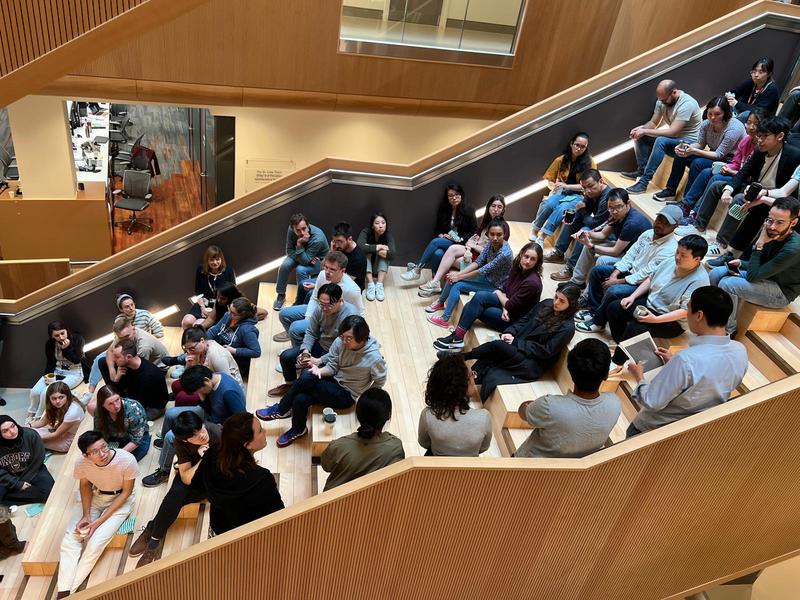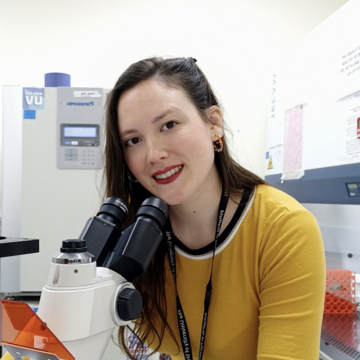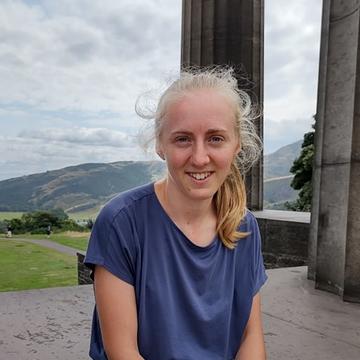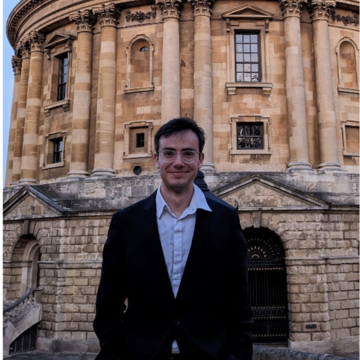Kavli INsD Researchers Conclude 2023 Academic Year with Inspiring 3-Minute Research Presentations, Fostering Interdisciplinary Collaboration and Advancing Nanoscience
Kavli INsD Researchers Conclude 2023 Academic Year with Inspiring 3-Minute Research Presentations, Fostering Interdisciplinary Collaboration and Advancing Nanoscience

Kavli INsD researchers closed off Trinity Term for the 2023 academic year with a fourth round of '3-Minute Research Presentations', a cherished tradition that fosters a vibrant inter-disciplinary research culture.
Our goal is to conduct exceptional nanoscience research within a scientific community that values collaboration. To foster a deeper understanding of each other's fields and methodologies, our dedicated researchers recently shared brief updates on their work on 29 June and 6 July.
Through this exchange, we aim to address significant health challenges such as antimicrobial resistance, brain and mental health, infectious diseases, and malaria. Additionally, we strive to develop innovative instrumentation that harnesses the analytical capabilities of the physical sciences to investigate cellular processes. Together, we are committed to making substantial contributions in these areas.
We are pleased to share our researcher’s presentation summaries below.

Navoneel Sen - Chemistry
Combining computational modelling with biophysical techniques for characterising proteins
I will be talking about one of my projects which aims to quantify the interaction between two proteins in the heart – Titin and alphaB crystallin. Titin is a giant muscular protein that is involved in maintaining passive stiffness in the heart and alphaB crystallin is a ubiquitously expressed small heat shock protein. We hypothesize that in the heart alphaB crystallin acts as a holdase and stiffens titin fibres and that this stiffening is essential for proper functioning. We use AlphaFold, a novel machine learning algorithm for protein structure prediction and mass spectrometry to investigate the interaction between these two proteins. We study the mode, specificity, and strength of this interaction. We also look into the effect of mutations on alphaBcrystallin that are thought to weaken the interaction thereby causing dilated cardiomyopathy.
#Computational modelling, #mass spectrometry, #molecular biology, #protein-protein interactions

Dr Daniel Zachor-Movshovitz - Chemistry
Revealing Red Blood Cells Extracellular Vesicles contents via Mass Photometry
Extracellular vesicles, EVs, are regularly secreted from cells carrying different cargo – i.e., proteins, DNA, RNA, etc., previous study shows red blood cells infected with malaria parasite secreted EVs (RBCEVs) contain proteins that help the growth of the parasite, one in particular is proteasome, weakening the cytoskeleton of an uninfected red blood cell allowing the parasite to infect other RBCs more easily. The current data gives a hint of the 20S, core particle of the proteasome and maybe a regulatory unit - - and we want to use Mass photometry to examine the EVs cargo and see which type of proteasome is it and thus learn of its function.
Why Mass photometry? because it’s easy to use and have a number of biological applications using solid lipid bilayers, membranes. I am trying to either cause leakage of the cargo in the EVs or cause the EVs to fuse to a solid lipid bilayer so the cargo will be released into the solution and measured by mass photometry. Important note is what is mass photometry – a light microscope designed to measure small changes in reflectance of a surface, in this case glass surface on top of which a protein of certain mass binds to. In doing so it reflects light differently than the glass itself and these two beams, the interference between them is measured (by a camera) and is proportional to the density and mass of the protein. Scan range is 30kDa to even mega Daltons. Easy to use and fast distribution of masses readout.
#RBCEVs, #Proteasome, #MassPhotometry, #MalariaParasite

Dr Rafael Carrascosa Marzo - Physics
Dynamic DNA origami and nanoscale printing
I work within DNA nanotechnology, making use of the DNA origami technique, to produce self-assembling complex designs in the nanoscale, made exclusively out of DNA. Particularly, I have made with my colleagues a 2D printing device that can precisely pattern a DNA surface with fluorophores.
#Nanotechnology, #DNA origami, #printing, #atomically precise manufacturing

Dr Ana Aragon-Gonzalez - NDCN
Using CRISPR to explore genetic variations on a Parkinson’s neuronal model.
As a new post-doctoral researcher at the Institute, I am excited to introduce myself and explore potential collaborations. My research focuses on using human stem cells to model dopaminergic neurons and other cell types involved in Parkinson's disease. With CRISPR, I am able to deactivate genes in our models. In Tofaris' lab, we focus on studying the cellular trafficking and aggregation of α-synuclein. To identify modifiers of its turnover and aggregation related to our target genes, I use various biochemical and microscopy techniques. Ultimately, my goal is to understand the pathomechanisms of Parkinson's disease.
#Parkinson; #i-PSCs; #CRISPR; #dopaminergic neuron; #glia

Lizzy Apsley - NDCN
Modelling human Purkinje cells using iPSC-derived cerebellar organoids
I study the development of the cerebellum, part of the brain important for coordination of motor function, as well as a broad range of higher cognitive functions such as language, memory and behaviour. My project focuses on developing and using a human-specific model for cerebellar development. I use human pluripotent stem cells to grow cerebellar organoids, 3D structures of cells that mimic features of the developing human cerebellum. This allows us to study early stages of cerebellar development, and I am particularly focused on investigating the role of a gene called FOXP2 in this. I have also extended the Becker lab protocol for growing human cerebellar organoids, developing a method to grow the neurons in 2D allowing a different range of assays including measuring neuronal activity.
#Cerebellum, #Organoids, #Purkinje cells

Sacha Salphati - Biochemistry
Synthetic nanobodies to investigate the role of lysosomal membrane proteins in health and diseases.
I am currently investigating the mechanisms, localizations and functions of lysosomal membrane proteins, which are essential to preserve cellular homeostasis. Single domain binders called synthetic nanobodies are being developed to study these poorly characterized proteins. This is an interdisciplinary project that makes the use of a range of techniques, including cryo-EM, super-resolution microscopy, membrane protein biochemistry and cell biology. These techniques are being combined with the synthetic nanobody technology to investigate how these proteins are organized at the lysosomal membrane to undertake their functions and how this is disrupted in diseases, including Parkinson’s disease in collaboration with the Wade-Martins Lab (Kavli Institute).
#Synthetic nanobodies, #membrane proteins, #lysosomes, #Parkinson’s Disease

James Eaton - Chemistry
Breaking Barriers in Protein NMR
NMR spectroscopy is invaluable for studying proteins in solution, allowing the exploration of dynamic regions. While protein structure relates to function, dynamics are equally critical in biochemical processes. Understanding protein dynamics is imperative to understand their functionality completely. NMR complements other techniques by uncovering unexpected protein functions resulting from molecular motion. However, NMR faces challenges in studying large proteins (>1MDa) due to poor signal intensity and resolution caused by fast relaxation. To address this, my research focuses on studying NMR relaxation to identify protein labels that enhance NMR spectra quality for large systems. This expands the range of high molecular weight species amenable to NMR study.
#NMR, #Protein Dynamics, #Large Proteins

Dr Becky Carlyle - DPAG
Proteomics of cellular resilience in Alzheimer’s Disease
The most common form of dementia, Alzheimer’s Disease, is characterized by damaging deposits in the brain of two proteins, amyloid and tau. Although everyone diagnosed with Alzheimer’s Disease has these protein deposits in their brain, not everyone who has these deposits experiences dementia. We call these people cognitively resilient. Discovering why these people are resilient, and designing medications to increase resilience in those at risk of dementia will improve the lives of future patients and their families. I am quantifyingthousands of proteins in the brain and discover where in nerve cells the proteins are active, and to see if there are groups of proteins that act together to make a person cognitively resilient. Studies like these usually discover hundreds of proteins that change in health versus disease, so after these experiments, I will test which proteins are the most important for protective effects, and for targeting with future medications. I will use cells from humans called induced pluripotent stem cells, which will be developed into nerve cells, and will test them to see how healthy they are when I change the levels of the proteins I’m interested in.
#Neuroproteomics, #neuroscience, #Alzheimer’s Disease, #cellular biology

Qian Zhang - Physics
A chemically fuelled motor for synthetic molecular machinery
Synthetic molecular motors and machinery made from DNA have demonstrated a range of interesting autonomous functions including sensing, computation, control of covalent synthesis and locomotion. The sources of energy for DNA nanomachines are generally either through the hydrolysis of the sugar-phosphate backbone or hybridization. DNA fuels have the distinct advantage of being programmable through sequence design to perform specific functions. However, typical cycle times for a strand displacement reaction are of the order of minutes. In contrast, the hydrolysis of ATP powers almost all classes of molecular machines in biological systems, and step times for ATP-powered biological molecular motors such as myosin or kinesin are of the order of milliseconds. My project aims to develop a biomimetic RNA motor which couples the hydrolysis of a generic chemical fuel to a conformational change of a synthetic molecular device by in vitro selection.
#Ribozyme, #molecular motor, #molecular machinery, #in vitro selection

Dr Maria Claudia Caiazza - DPAG
iPSC-derived models of Parkinson's to study intracellular calcium using high throughput calcium imaging and functional genomics
In my research, I use stem cells to grow in the lab dopamine neurons from Parkinson's patients. These lab-grown neurons allow us to study the disease more closely and understand how it develops. Specifically, I focus on calcium homeostasis using calcium imaging to resolve calcium homeostasis at the subcellular compartment level. Additionally, I employ CRISPR intereference to investigate the impact of specific genes on calcium regulation and how it affects the neurons.
#Parkinson, #stemcells, #calcium

Dr Jin Chuan Zhou - Biochemistry
Cryo-EM applications in neurobiology
I am focused at understanding the function of neurodevelopmental proteins whose mutations have been implicated in mental illnesses such as schizophrenia and depression. I use a combination of atomic-resolution imaging (i.e. cryo-EM) as well as cell model assays to uncover the molecular basis for the target proteins’ function in the brain.
#Neurobiology; #Structural biology; #cryo-EM; #Biochemistry


